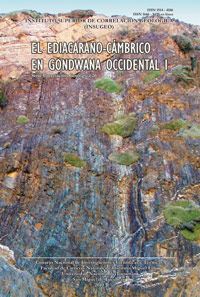Serie Correlación Geológica 26
Estructuras microbiales y algales de zona fótica en la Formación Puncoviscana, provincia de Salta, Argentina.
Florencio Gilberto Aceñolaza | Miguel B. Azarevich | Vanina L. López de Azarevich | Ricardo H. Omarini
Descargar trabajo en formato PDFResumen
ESTRUCTURAS MICROBIALES Y ALGALES DE ZONA FÓTICA EN LA FORMACIÓN PUNCOVISCANA, PROVINCIA DE SALTA, ARGENTINA.- Se describe el perfil estratigráfico de la Formación Puncoviscana en la localidad de Palermo Oeste, Salta, donde se reconoce la existencia de una secuencia sedimentaria de 63 metros. En su sección basal se ha reconocido la existencia de estructuras microbiales y algales. La asociación litofacial permite interpretar la secuencia como un depósito de planicie de marea, en la cual la actividad biogénica ha tenido un rol importante a lo largo de la totalidad del período de sedimentación registrado. Los sub-ambientes reconocidos son de cara de playa e intermarea. El material fósil identificado consiste en: i) trazas fósiles diversas en biofacies de Nereites saltensis, ii) Kinneya, que sugiere un desarrollo por debajo de las matas microbiales, iii) “Elephant skin”, cuyo desarrollo se produce en la superficie de matas microbiales, iv) estructuras algales similares a Phaeophycaceae, del grupo de “Fucus”, v) “wrinkle marks”, posiblemente asociadas a procesos conjuntos biológicos y físicos (orgánicos/sedimentarios). El grupo de algas reconocido se desarrolla en la zona litoral intermareal a sublitoral dentro de la zona fótica, y son características de aguas relativamente transparentes frías a templadas. Las algas feofíceas han sido reconocidas en todos los mares del mundo y su registro cronológico varía entre el Ediacarano terminal y el Fanerozoico.
Abstract
MICROBIAL AND ALGAL STRUCTURES FROM THE POTHIC ZONE IN THE PUNCOVISCANA FORMATION, SALTA PROVINCE, ARGENTINA.- A stratigraphic profile has been described in the Puncoviscana Formation in Palermo Oeste locality, Salta, were a 63 m-thick sequence was recognized. In the basal section was recognized the presence of microbial and algal structures. Lithofacies associations allow interpretation of the sedimentary sequence as tidal flat deposits, within which the biogenic activity had an important roll along the whole registered sedimentation period. Recognized sub-environments are shoreface and intertidal. The identified fossil material consist of: i) diverse trace fossils indicating Nereites saltensis biofacies, ii) Kinneya, that suggests a development beneath microbial mats, iii) “Elephant skin”, which development is produced on the surface of microbial mats, iv) algal structures similar to Phaeophycaceae, “Fucus” group, v) “wrinkle marks”, possible associated to mixed biologic and physical process (organic/sedimentary). The recognized group of algae is developed in litoral intertidal to sublitoral zone within the photic zone, and are characteristic of warm to cold relative transparent waters. Phaeophycaceae algas has been recognized in all seas around the world and its chronological register varies between the final Ediacara and the Phanerozoic.






